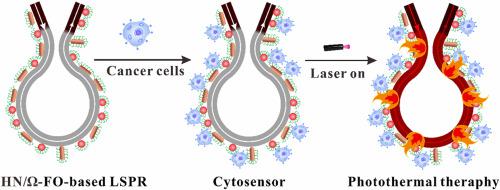Biosensors and Bioelectronics ( IF 12.6 ) Pub Date : 2021-08-30 , DOI: 10.1016/j.bios.2021.113599 Lu He 1 , Fan He 2 , Yanting Feng 1 , Xu Wang 3 , Yongxin Li 4 , Yonghui Tian 1 , Aihua Gao 2 , Pei Zhang 1 , Xinyuan Qi 2 , Zewei Luo 1 , Yixiang Duan 1

|
Inadequate sensitivity and side-effect are the main challenges to develop cytosensors combining with therapeutic potential simultaneously for cancer diagnosis and treatment. Herein, localized surface plasma resonance (LSPR) based on hybridized nanolayer modified Ω-shaped fiber-optic (HN/Ω-FO) was developed to integrate cytosensor and plasmonic photothermal treatment (PPT). On one hand, hybridized nanolayers improve the coverage of nanoparticles and refractive index sensitivity (RIS). Moreover, the hybridized nanoploymers of gold nanorods/gold nanoparticles (AuNRs/AuNPs) also result in intense enhancement in electronic field intensity (I). On the other hand, Ω-shaped fiber-optic (Ω-FO) led to strong bending loss in its bending part. To be specific, a majority of light escaped from fiber will interact with HN. Thus, HN/Ω-FO synergistically enhances the plasmonic, which achieved the goal of ultrasensitive cytosensor and highly-efficient plasmonic photothermal treatment (PPT). The proposed cytosensor exhibits ultrasensitivity for detection of cancer cells with a low limit of detection down to 2.6 cells/mL was realized just in 30 min. HN/Ω-FO-based LSPR exhibits unique characteristics of highly efficient, localized, and geometry-dependent heat distribution, which makes it suitable for PPT to only kill the cancer cells specifically on the surface or surrounding fiber-optic (FO) surface. Thus, HN/Ω-FO provides a new approach to couple cytosensor with PPT, indicating its great potential in clinical diagnosis and treatment.
中文翻译:

杂化纳米层改性Ω形光纤协同增强局部表面等离子体共振,用于超灵敏细胞传感器和高效光热治疗
灵敏度不足和副作用是开发细胞传感器与癌症诊断和治疗同时具有治疗潜力的主要挑战。在此,开发了基于杂化纳米层改性Ω形光纤(HN/Ω-FO)的局域表面等离子体共振(LSPR)以集成细胞传感器和等离子体光热处理(PPT)。一方面,杂化纳米层提高了纳米粒子的覆盖率和折射率灵敏度 (RIS)。此外,金纳米棒/金纳米粒子(AuNRs/AuNPs)的杂化纳米聚合物也导致电场强度的强烈增强(I)。另一方面,Ω形光纤(Ω-FO)导致其弯曲部分有很强的弯曲损耗。具体而言,从光纤逸出的大部分光将与 HN 相互作用。因此,HN/Ω-FO协同增强等离子体,实现了超灵敏细胞传感器和高效等离子体光热处理(PPT)的目标。所提出的细胞传感器对癌细胞的检测具有超灵敏性,仅在 30 分钟内就实现了低至 2.6 个细胞/mL 的检测限。基于 HN/Ω-FO 的 LSPR 具有高效、局部和几何相关的热分布的独特特性,这使得 PPT 适合仅杀死表面或周围光纤 (FO) 表面的癌细胞。因此,HN/Ω-FO 提供了一种将细胞传感器与 PPT 结合的新方法,



























 京公网安备 11010802027423号
京公网安备 11010802027423号